UPDATE: While I have made 7 successful batches, it appears that many folks are running into trouble with this recipe. I recently made an 8th batch and it failed to gel.
I have since experimented with several pectins and taken the advice of Stephanie, a reader, and switched to Dutch Gel Pectin which works like a treat! Simply use a generously rounded 2/3 cup of the Dutch Gel and VOILA! Thanks so much to Stephanie for the great idea!
My husband lives, breathes, sleeps, drinks, and eats coffee. I mean REALLY.
We tea drinkers often get a reputation as being high maintenance, but my husband takes the cake with his coffee rules. The guy opts to drive rather than fly on all business trips under 12 hours so he can take HIS coffee and HIS coffee maker with him.
He gets it delivered automatically every month through Amazon.com because running out of coffee? Well, that’s simply unacceptable.
His love for coffee runs to all things coffee related with the singular exception of coffee yogurt which just “isn’t right”.
So after our grand trip to the Western Caribbean a couple of months ago which included a stop in Honduras where they had roughly 4 million coffee related gift shops he was in coffee lover’s heaven.
One of the shops in Roatán sold coffee jelly. The moment I saw it, I knew I’d be making it at home. How could I not?
I got home and started experimenting, beginning with my go-to pectin: Pomona’s Universal Pectin. I use Pomona’s for all the jams and jellies I make here during the summer and fall months.
It has never failed me and so I expected it to perform like a treat here. I was beyond shocked when my first 4-cups-of-coffee batch failed to set. “No problem! It’s coffee syrup!” I thought, and handed it out to friends as such.
I increased the pectin in Batch 2, and had a slightly thicker syrup, but still no set! What the heck? Batches 3, 4, and 5 were made after consulting with their helpline, but still yielded a thick syrup that was most certainly not a jelly.
At this point, I had blown through 14 cups of coffee (the last two batches having been smaller, experimental sized batches) and finally decided to throw a Hail Mary by using a box of my long-ago-abandoned SureJell.
I went all in with another 4-cup batch (because SureJell doesn’t lend itself to increasing or decreasing the batch size) and held my breath after removing the processed jars from the pot of hot water.
Since then, we have discovered that Dutch Gel is actually the most foolproof of all of the available pectins I have used.
It was PERFECT. It had the ideal jelly texture and viscosity and was a sight to behold.
Upon reflection (and discussion with my sister who is also a devoted Pomona’s user), I think the reason Pomona’s failed here when it has never failed before is a quirky one.
Pomona’s gelling action is activated by a low sugar environment (which I used in my experiments) and the addition of calcium water. Coffee has been proven to leach calcium from bones (it’s on the watch list of foods to avoid if you have osteoporosis) so my theory is that it prevents the calcium water from activating the pectin.
Like I said… it’s a theory, but it’s the only reason I can think of that Pomona’s wouldn’t do the job it’s so good at doing.
…And that is the story both of how Dutch Gel found a small place on my shelves (next to the Pomona’s) for one single use, and how I blew through a 32 ounce bag of my husband’s coffee beans and he was relegated to eating a jar of Coffee Jelly for breakfast and was quite surly until I overnighted a new bag here the next day from Amazon. Ahem. Whoops. Sorry, honey.
Cook’s Notes
-
- I’m going to go ahead and say it. Dutch Gel is the best option for pectin here. Pomona’s failed absolutely in every single variation I tried.
-
- Don’t get weirded out by the presence of lemon juice in the recipe. For starters, it’s absolutely necessary to make this a safe item to can. The acidity is what prevents microbial growth in the jar, so it’s not optional to omit it.
Secondly, though, you really don’t taste it. It does a good job of brightening the coffee flavour without being overtly lemony. (Besides this, there are nations in the world where serving lemon with coffee is pretty standard!)
- Don’t get weirded out by the presence of lemon juice in the recipe. For starters, it’s absolutely necessary to make this a safe item to can. The acidity is what prevents microbial growth in the jar, so it’s not optional to omit it.
-
- Don’t be tempted to diminish the amount of sugar in the recipe. Dutch Jel is designed to work with a specific range of sugar and this recipe was tested using exactly 5 1/2 cups of the sweet stuff.
In order to make it lower sugar, you have to use a low-sugar pectin, and my experiments with that (specifically Pomona’s) were abject failures. Think of this as a sweet treat.
- Don’t be tempted to diminish the amount of sugar in the recipe. Dutch Jel is designed to work with a specific range of sugar and this recipe was tested using exactly 5 1/2 cups of the sweet stuff.
-
- Are you wondering what to do with a batch of Coffee Jelly? Do you have coffee lovers in your life? Give them a jar for the holidays! Coffee Jelly is a great Christmas stocking stuffer!
You can spread it on toast or do like my husband loves: spoon onto Simple French Toast then top with whipped cream and a dusting of cocoa powder!
- Are you wondering what to do with a batch of Coffee Jelly? Do you have coffee lovers in your life? Give them a jar for the holidays! Coffee Jelly is a great Christmas stocking stuffer!
- This jelly is a great beginning canning project. If you need help with canning basics, SEE THIS PAGE.
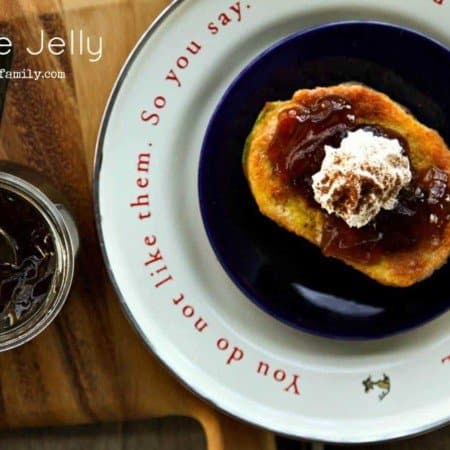
Coffee Jelly
Rate RecipeIngredients
- 4 cups VERY strongly brewed coffee preferably a darker roast
- 1/4 cup lemon juice
- 5 1/2 cups granulated sugar
- 1 1/3 cups Dutch gel pectin
Also needed:
- 5 to 6 jelly jars with new two-piece lids. 8 ounce
Instructions
- Stir the coffee and lemon juice together in a 4 quart saucepan and bring to a boil over high heat. In a separate bowl, whisk together the sugar and Dutch Gel Pectin. Add the sugar to the boiling coffee mixture all at once, and whisk vigorously for 2 minutes, or until the pectin and sugar are fully dissolved into the solution. Return the mixture to a full rolling boil, and boil for exactly 1 minute. Remove the pan from the heat, ladle into clean 8 ounce jars, wipe the rims with a damp paper towel, and screw on new, two-piece lids until fingertip tight.
- Use the Boiling Water Bath method to process the jars for 10 minutes. Carefully transfer to a cooling rack or a tea towel on the counter and let cool, undisturbed, overnight. After the jars are cooled, remove the rings, wipe clean, and label. The jelly should be stored in a dark place -preferably a cool one- free of temperature fluctuations. It is best used within the year.
Nutrition
Nutritional information is an estimate and provided to you as a courtesy. You should calculate the nutritional information with the actual ingredients used in your recipe using your preferred nutrition calculator.
did you make this recipe?
Make sure to tag @foodiewithfam on Instagram and #hashtag it #foodiewithfamily so I can check it out!
This post originally published November 2014, updated with video and improved cook’s notes in October 2018.
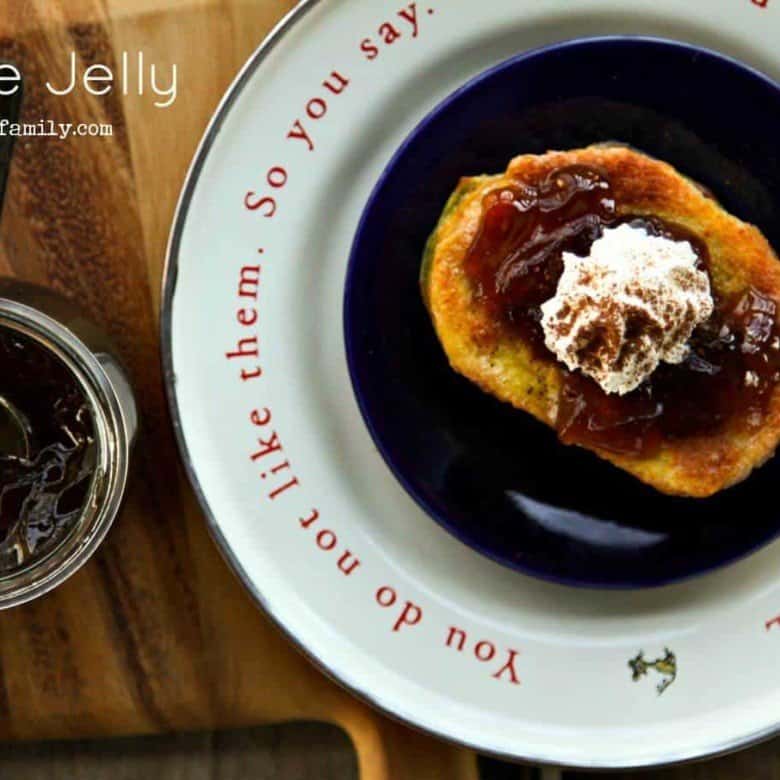
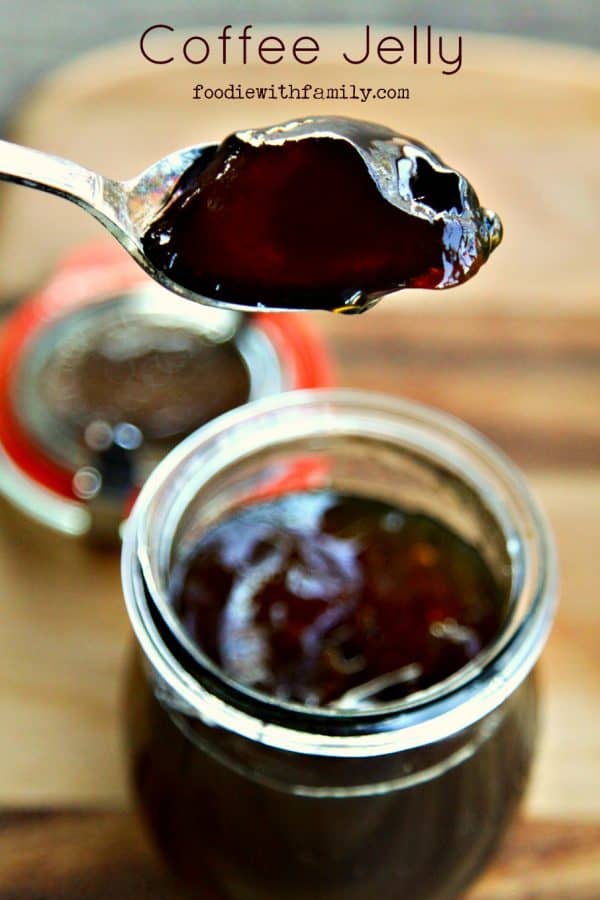
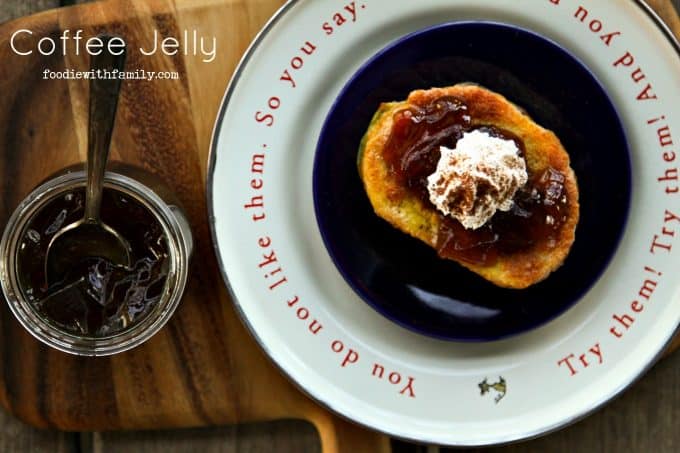
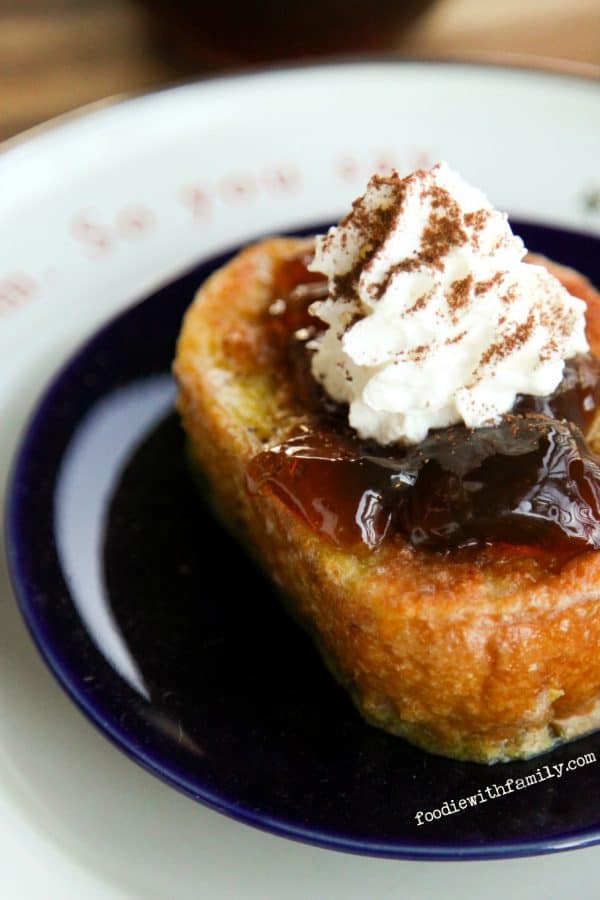



Reader's Thoughts...
Melissa says
I’m not sure what went wrong I followed the recipe and it only partially jelled. What went wrong ? Can someone tell me why it only partially jelled? I will retry after I hear from someone.
Valerie says
Just made this, waiting for jars to ping! Can’t wait to try on biscuit or toast. The Taste I tried was great ! Has Strong coffee flavor😀
Rebecca says
Thank you for taking the time to rate the recipe and let me know you love it, Valerie! I so appreciate it!
katrina says
Is this a safe tested recipe?
Rebecca says
It is based on the accepted parameters for acidity and home tested with acid levels. It is not lab tested.
Dee says
Are the calories stated per jar, or per tablespoon?
Rebecca says
Hi Dee- that’s per cup. 😉
Lise McKinney says
What pH is needed? I’m allergic to lemons so I will have to find an alternative.
Rebecca says
Hi Lise- You can also use citric acid but I’m not sure what the equivalent volume is you’d need. I’m afraid you’ll need to do a little research on that one. Best of luck!
Sally says
can sure jell pectin be used? if so how much should be used?
Elisabeth says
At what point does it set and become firm?
Rebecca says
It should set up over the course of a couple of days. If it is still runny, you may need to return it to the pot and gel it with more clear-gel.
Melanie Harris says
For the lemon juice, fresh squeezed, bottled lemon juice? What is recommended? Thanks.
Rebecca says
Hi Melanie- While fresh lemon juice tastes better, the bottled stuff is usually the recommendation for canning since it is a uniform acidity and the lemon is added here to help assure safety in canning.
Claire Desrochers says
Can you explain why in your write up it says 2/3 cup of Dutch gel pectin but in your recipe it says 1 1/3 cups. Which is it? Also the videos directions are not the same as the written instructions.
Thank you.
Claire
Regina says
I would love to know the correct measurements.